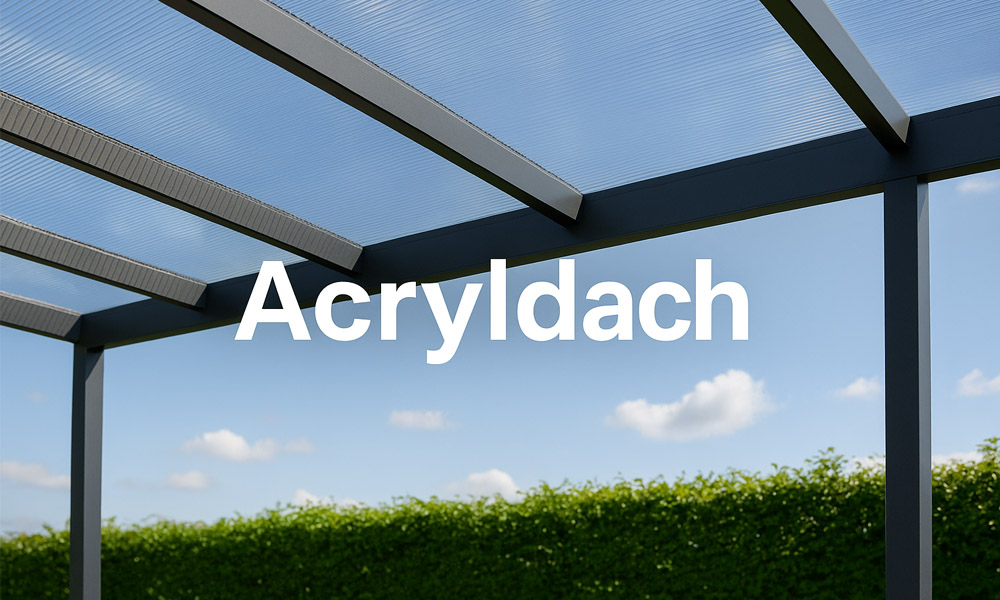Home Improvement
Acryldach: The Light-Loving, Weather-Proof Roof You’ll Actually Love
Published
5 months agoon
By
George
Imagine relaxing on your patio with sunshine gently pouring in — but without getting burned or wet. You feel the warmth of the day, but not the wind or rain. That’s exactly what Acryldach offers — a clear, modern roof that brings in the light while keeping out the bad weather. And in 2025, more people are choosing it than ever before.
If you’re thinking about building a patio cover, greenhouse, carport, or even a sunny café space, you’ve probably seen or heard the word Acryldach. But what is it, really? Why is it suddenly so popular? And is it better than glass or other plastics?
In this article, we’re going to explain everything you need to know about Acryldach — clearly and simply. You’ll learn what it is, how it works, where it’s used, and why it might be the perfect choice for your next project.
Let’s dive in.
What is Acryldach?
The word Acryldach comes from German. “Acryl” means acrylic, and “Dach” means roof. Put them together, and you get “acrylic roof.” But don’t let the name fool you — this isn’t some boring plastic sheet.
Acryldach is made from a special type of plastic called PMMA (that’s just the technical name). Many people also know it as Plexiglas, which is a popular brand name. It’s a strong, clear material that lets sunlight pass through while keeping out rain, snow, and wind.
You’ll often find Acryldach used on patios, greenhouses, pergolas, carports, and even public spaces like bus shelters. Why? Because it gives you all the benefits of glass — like clear views and brightness, without the weight or risk of breaking.
Think of it as a window for your roof. Only lighter, safer, and easier to install.
Why is Acryldach So Popular in 2025?
In 2025, homeowners and builders are looking for smarter, cleaner, and more natural ways to cover outdoor spaces. That’s where Acryldach really shines.
People love natural light. It makes spaces feel bigger, warmer, and more welcoming. Acryldach lets that light in without making the space too hot or exposed. It protects you from rain and UV rays, but still feels open and airy.
Also, more people are working from home or enjoying time in their gardens and patios. Acryldach creates the perfect setting — whether it’s a sunny reading spot, a place to grow plants, or a covered carport that still looks great.
In short, Acryldach is trending because it’s practical, beautiful, and easy to use — everything people want in a modern roof.
How Does Acryldach Work?
Acryldach works in a very simple but smart way. The panels are clear or tinted sheets of strong acrylic that are installed over a frame. These panels let sunlight in, just like glass, but they’re much more durable and lightweight.
Most high-quality Acryldach panels also have a UV-protection layer on one side. This layer blocks harmful sun rays while still letting the light through. That means your space stays bright and safe — and your furniture and plants won’t fade or burn.
The panels are also built to handle bad weather. Rain, snow, wind — no problem. Acrylic is waterproof, doesn’t rust, and won’t rot like wood. It also doesn’t shatter like glass, which makes it safer for families, pets, and outdoor areas.
It’s like having a shield above you that’s clear, calm, and tough at the same time.
Where Can You Use Acryldach?
One of the best things about Acryldach is how versatile it is. You can use it in so many places — big or small, at home or in public.
Let’s say you want to build a cozy patio area. Acryldach gives you a roof that lets in sunlight, so your mornings feel fresh and warm, but you’re still protected when it rains. It’s also perfect for pergolas, letting you sit outside without worrying about the weather.
For carports, it’s a smart option too. Your car stays covered and safe from hail, snow, or falling leaves, but the roof doesn’t make the area feel dark or closed-in like some metal covers do.
If you have a greenhouse or garden room, plants love Acryldach. They get all the light they need without the harmful UV. And if you’re running a small café or outdoor shop, it adds style and brightness without the cost of full glass walls.
Even public places like bus stops, walkways, and playgrounds now use Acryldach. It keeps people dry and safe but doesn’t block the natural light, which makes everything feel better.
Different Types of Acryldach to Choose From
Acryldach isn’t just one single kind of panel. There are actually many different types, depending on what you need and how you want it to look.
One common type is the flat clear sheet. This one looks smooth and shiny — like glass — and is great if you want a clean, modern look. It gives you a perfect view of the sky and feels open and bright.
Then there are corrugated sheets. These have a wavy shape and are often used on garages, sheds, or larger outdoor spaces. The wave design helps rain slide off more easily and adds extra strength.
Another type is the multiwall or twinwall sheet. This kind has air pockets inside, like a honeycomb. It’s not as clear as flat sheets, but it keeps heat in during winter and out during summer. People often use these in greenhouses and sunrooms.
You can also choose Acryldach in different colors — opal (milky white), bronze, grey, or even frosted for more privacy. There’s a style for every taste and every type of space.
Benefits of Acryldach You’ll Really Notice
There are many reasons why people love using Acryldach. One of the biggest is how it lets in natural light. Unlike wood or metal roofs, Acryldach gives you that warm, sunny feeling even when you’re sitting under a cover. It makes your patio or carport feel open and bright instead of dark and closed off.
It’s also very strong. Acryldach may look like glass, but it’s much lighter and won’t shatter. That makes it safer, especially if you have kids or pets. It can handle tough weather like wind, rain, or even light hail without any trouble.
Another great benefit is that it’s easy to care for. You don’t need to repaint it, patch it, or do much cleaning. And because it doesn’t rust or rot, you won’t have to worry about replacing it every few years. It’s a smart long-term choice for anyone who wants both beauty and durability.
Acryldach vs Glass, Polycarbonate, and PVC
You might be wondering how Acryldach compares to other roof materials like glass, polycarbonate, or PVC. Let’s break it down in a simple way.
Glass looks nice but is very heavy. It can break easily and needs strong support. Acryldach gives you a similar clear look, but without the weight or danger of breaking. It’s also much easier to install and less expensive.
Polycarbonate is super strong and great for very rough weather. But it’s often more expensive than Acryldach and doesn’t look as clear. If you want something that balances looks and strength, Acryldach is a great middle option.
PVC is the cheapest, but it doesn’t last long. It can turn yellow in the sun and crack in cold weather. It also doesn’t look as clean or modern as Acryldach. So while PVC saves money at first, Acryldach is often the better long-term choice.
How to Install Acryldach the Right Way
One reason Acryldach is so popular in 2025 is that it’s easy to install, even for beginners. You don’t need fancy tools or heavy equipment. Many people install it themselves with just a few basic tools.
Start by measuring your space. Make sure you buy the right size and number of panels. Most Acryldach panels can be cut using a fine-tooth saw. Just take your time and wear gloves and safety glasses.
Leave a small gap between panels to allow for heat expansion. Acrylic expands slightly in warm weather, and if you don’t leave space, the panels can crack. Always use special screws with rubber washers and don’t screw them in too tight.
And most importantly, make sure the roof has a slight slope. Even a 5-degree angle is enough. This helps rainwater flow off instead of pooling, which protects your roof for the long run.
Common Mistakes to Avoid
While installing Acryldach is simple, a few small mistakes can cause big problems later. Let’s look at what to avoid.
First, don’t install the UV-protected side facing down. Most Acryldach sheets only protect one side from the sun. If you place it upside down, the roof can turn yellow or brittle within months. Always check the label.
Second, never fit the panels too tightly together. Acryldach expands in the heat, so tight panels can crack or pop out of place. A small gap makes a big difference.
Lastly, always install with a slope. Flat roofs collect rainwater, which leads to stains, leaks, or even damage. A simple angle helps water drain off safely and keeps your roof looking new.
Keeping Acryldach Clean and Shiny
One of the best things about Acryldach is how little cleaning it needs. Rain will often wash off most dust and dirt, but it still helps to rinse your panels every few weeks, especially if you live near trees or a dusty road.
If your roof needs deeper cleaning, use a soft sponge or cloth with mild soapy water. Never use rough brushes or strong cleaners. Chemicals like ammonia can damage the surface and cause it to go dull or crack.
Also, check the screws and panel edges once or twice a year. If something looks loose or worn out, fix it quickly. A little care goes a long way and keeps your Acryldach looking clear and strong for many years.
Is Acryldach Safe and Eco-Friendly?
Yes, absolutely. Acryldach is safe for people, pets, and plants. It doesn’t give off harmful chemicals like some cheap plastics. That means you can use it over patios, gardens, or even spaces where children play.
It’s also fully recyclable. When your panels reach the end of their life, they can be melted down and reused. That means less waste and a smaller impact on the planet.
Plus, because Acryldach brings in natural light, it helps you use less electricity during the day. That’s good for your energy bill and the environment. In 2025, more people are choosing Acryldach not just for its look — but because it’s a smart, green choice too.
Is Acryldach Worth the Cost?
For many people, yes — it’s totally worth it. While Acryldach costs more than PVC, it also lasts much longer, looks much better, and needs less care. When you think about how many years you’ll enjoy it without worry, it becomes a very good investment.
Basic panels may cost around $12 to $40 per square meter, depending on the type and location. Installation costs more if you hire someone, but many people save money by doing it themselves.
And don’t forget — it makes your space brighter, more beautiful, and even more valuable. Whether it’s a backyard patio or a café garden, Acryldach adds something special that lasts for decades.
Bottom-Line
If you want a roof that’s bright, stylish, strong, and easy to care for, then Acryldach is a perfect choice. It works for so many places — patios, pergolas, greenhouses, carports — and it’s loved by homeowners and builders alike.
Acryldach gives you all the beauty of glass, without the risk or weight. It’s clear, modern, and tough enough to handle years of sun and rain. It’s also eco-friendly, safe, and smart for 2025 living.
So whether you’re upgrading your outdoor space or building something brand new, try Acryldach — and enjoy the sunshine without the stress.
(FAQs)
Can Acryldach really last over 30 years without turning yellow?
Yes! High-quality Acryldach with UV protection can stay clear and strong for 30+ years — even under full sun.
Is it true that Acryldach can crack just from tight screws?
Surprisingly, yes. If you screw panels too tightly, they can crack over time due to heat expansion. A small gap makes a big difference.
Can you ruin your Acryldach roof in just one summer?
Yes — if you install the UV-protected side facing down, it can turn yellow, brittle, and fail in just a few months.
Is Acryldach really lighter than glass but just as clear?
Absolutely. It’s about half the weight of glass and still lets in up to 92% of natural light — safer and easier to install too.
Can Acryldach cut your energy bill?
Yes! It lets in so much sunlight that you may use less electricity during the day, especially in patios and greenhouses.
You Might Also Like: Brandi Loge

Data Privacy and Confidentiality in Legal AI: Keeping Sensitive Matters Secure

Jodi Faeth: What Happened to Mike Wolfe’s Ex-Wife After Divorce?

How GEO Helps Startups Compete With Enterprise-Level AI Visibility

Who Is Cassandra Marino? Caitlyn Jenner’s Daughter Who Lives a Private Life

Get to Know Nathan Andersen: A. J. Cook’s Husband and Proud Family Man

From Digital to Tangible: The Human Impact of Cryptocurrency to Fiat Adoption

The Real Story of Melissa Meeks, Jeremy Meeks’ Famous Ex-Wife

MegaCustom: Personal Gifts Made Beautiful

Design Something Special with MegaCustom

Top 10 SEO Agencies for Barber Shops

Who Is Marlene Knaus? The Untold Story of Niki Lauda’s First Wife

Curious About JOI Database? Read This First Before You Click Anything

Jacqueline Bernice Mitchell: The Inspiring Story of Jerry Rice’s Ex-Wife

Should You Use Wooflix in 2025? Honest Review and Best Alternatives

Where Is Noelle Watters Now? Jesse Watters’ Ex-Wife’s Life After Divorce

Where Is Barbara Boothe Now? Inside Her Life After Larry Ellison

Alisande Ullman Today: What Happened After Her Divorce from Leslie Nielsen?

Where Is Tanya Hijazi Now?: All About Rick James’ Former Wife

Wendy Lang: Meet the Therapist Married to Cenk Uygur

Mickey Middleton: The Untold Story of Bryan Cranston’s First Wife

Data Privacy and Confidentiality in Legal AI: Keeping Sensitive Matters Secure

Jodi Faeth: What Happened to Mike Wolfe’s Ex-Wife After Divorce?

How GEO Helps Startups Compete With Enterprise-Level AI Visibility

Who Is Cassandra Marino? Caitlyn Jenner’s Daughter Who Lives a Private Life

Get to Know Nathan Andersen: A. J. Cook’s Husband and Proud Family Man

From Digital to Tangible: The Human Impact of Cryptocurrency to Fiat Adoption

The Real Story of Melissa Meeks, Jeremy Meeks’ Famous Ex-Wife

MegaCustom: Personal Gifts Made Beautiful

Design Something Special with MegaCustom

Top 10 SEO Agencies for Barber Shops
Categories
Trending
-

 Celebrity6 months ago
Celebrity6 months agoWho Is Marlene Knaus? The Untold Story of Niki Lauda’s First Wife
-

 Entertainment5 months ago
Entertainment5 months agoCurious About JOI Database? Read This First Before You Click Anything
-

 Celebrity3 months ago
Celebrity3 months agoJacqueline Bernice Mitchell: The Inspiring Story of Jerry Rice’s Ex-Wife
-

 Entertainment5 months ago
Entertainment5 months agoShould You Use Wooflix in 2025? Honest Review and Best Alternatives
